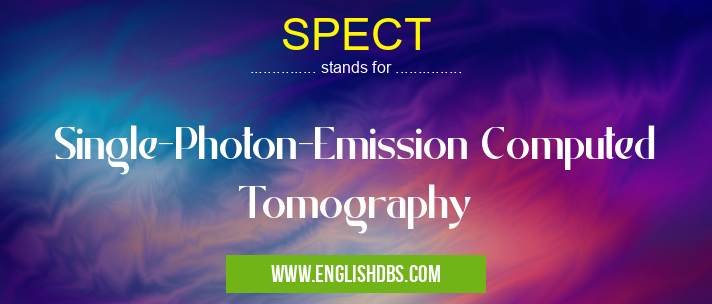What does SPECT mean in MEDICAL
Single-Photon-Emission Computed Tomography (SPECT) is a specialized medical imaging technique used to assess physiological processes and detect abnormalities in different organs and tissues. It involves the administration of a small amount of radioactive tracer into the body, which targets specific areas of interest.

SPECT meaning in Medical in Medical
SPECT mostly used in an acronym Medical in Category Medical that means Single-Photon-Emission Computed Tomography
Shorthand: SPECT,
Full Form: Single-Photon-Emission Computed Tomography
For more information of "Single-Photon-Emission Computed Tomography", see the section below.
How does SPECT work?
SPECT utilizes a gamma camera to capture images of the distribution of the radioactive tracer within the body. As the tracer emits single photons, the gamma camera detects their location and intensity, providing information about the metabolic activity or blood flow in the targeted areas. The data is then processed using computer algorithms to create three-dimensional images, enabling detailed visualization of the targeted organs.
Applications of SPECT
SPECT has a wide range of applications in medical diagnostics, including:
- Cardiac Imaging: Assessing myocardial perfusion (blood flow) and identifying areas of ischemia or infarction in heart disease.
- Neurological Imaging: Detecting abnormalities in brain function related to conditions such as Parkinson's disease, dementia, and epilepsy.
- Oncological Imaging: Evaluating the spread of cancer, assessing treatment response, and monitoring for recurrence.
- Infectious Disease Imaging: Identifying areas of infection or inflammation, such as in osteomyelitis or pneumonia.
- Renal Imaging: Assessing kidney function and detecting abnormalities such as renal cysts or tumors.
Benefits of SPECT
- Provides functional information about organs and tissues, complementing anatomical images obtained from other imaging modalities.
- Relatively non-invasive, involving the injection of a small amount of radioactive tracer.
- Offers high sensitivity and specificity, allowing for accurate diagnosis of a wide range of conditions.
Essential Questions and Answers on Single-Photon-Emission Computed Tomography in "MEDICAL»MEDICAL"
What is SPECT?
SPECT (Single-Photon-Emission Computed Tomography) is a medical imaging technique that uses a radioactive tracer to create detailed 3D images of the body's organs and tissues. It helps doctors diagnose and monitor various conditions, such as heart disease, cancer, and brain disorders.
How does SPECT work?
A small amount of radioactive tracer is injected into the body, which accumulates in the target organs or tissues. A gamma camera detects the emitted photons and uses them to create cross-sectional images. Computer processing combines these images to form a 3D reconstruction.
What are the benefits of SPECT?
SPECT provides functional and anatomical information about the target area, helping doctors assess organ function, detect tumors, and monitor treatment progress. It is non-invasive, widely available, and relatively inexpensive.
Are there any risks associated with SPECT?
The radiation exposure from SPECT is generally low and considered safe. However, it is not recommended for pregnant women or people with certain allergies.
How should I prepare for a SPECT scan?
Inform your doctor about any allergies or health conditions you have. You may need to fast or discontinue certain medications before the scan. Follow the specific instructions provided by your healthcare provider.
What happens during a SPECT scan?
You will lie down on a table, and a radioactive tracer will be injected into your body. A gamma camera will rotate around you, capturing images of the tracer distribution. The procedure typically takes 30-60 minutes.
What is the difference between SPECT and PET (Positron Emission Tomography)?
Both SPECT and PET use radioactive tracers to create images, but they use different types of tracers. SPECT uses single-photon tracers, while PET uses positron-emitting tracers. PET generally provides higher resolution images, but it is more expensive and less widely available.
Final Words: SPECT is a valuable medical imaging technique that provides detailed information about the physiological functioning of different organs and tissues. It plays a crucial role in diagnosing and managing various diseases, aiding in the provision of optimal patient care.
